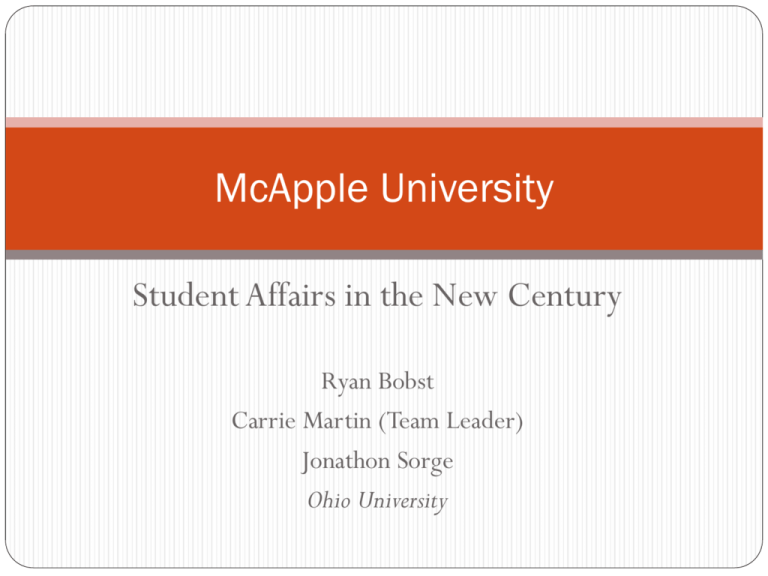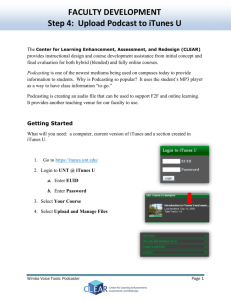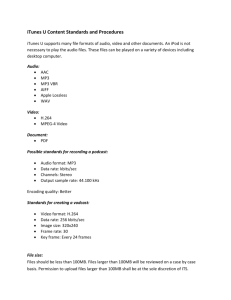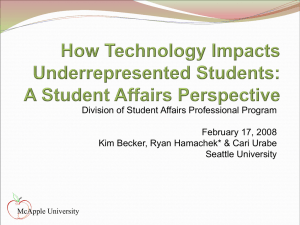OhioUniversity_martin
advertisement

McApple University Student Affairs in the New Century Ryan Bobst Carrie Martin (Team Leader) Jonathon Sorge Ohio University Overall Assumptions Students who attend McApple University are technology savvy. An extensive wireless network is available throughout the campus to be used for free. Ample funding is available to back-up these ideas. iPods/iTunes U Assumptions: McApple University does not use iTunes U. Universities that currently utilize iTunes U include: Vanderbilt, Texas A&M, Stanford, MIT, and UC Berkley. An iPod will have the ability to act as a GPS in the future. Most students at the school have and use iPods. iTunes U is effective in engaging students. “Students, professors, and even alums are excited to have such a direct connection to campus life.” (http://www.apple.com/education/itunesu_mobilelearning/ administrators.html) iPods/iTunes U, cont. Proposed Programs: “iTour “ Could be used for orientation. iPods would have a GPS component, which builds on current technology to act as a campus map. “Students across the USA can download…a virtual architectural tour of campus.” (Fuson, 2006) Students would be encouraged to take a tour at their leisure during Welcome Day programs. Podcasts could be available in all areas to hold staff meetings. Disability Services Classroom lectures could be translated in sign language on video for download. iPod/iTunes U, cont. Proposed Programs, cont. Student Activities Programs, speakers, and lectures could be available for download. “How to Get Involved” Pod cast Student organizations could have “commercials” to promote their group and programs. Career Services “How-To” classes could be available on podcast (ex: building a resume or interview skills) Laptops Assumptions: Computers are currently available for students to use in the library and computer labs on campus. Some students bring their own personal computers to school. All students who attend McApple University know how to use laptop computers. “A personal computer is a real necessity for the present day college student.” (Pfaffenberger, 1985) Laptop computers are preferred by students. “They [students] like portability, and they are frustrated by technology that tethers them to a specific location.” (Carlson, 2006) Laptops, cont. Proposed Programs: Improved Accessibility Laptop computers can be provided to all students. This cost would be added to the student’s school fees. Coincide with iTunes U program Students could easily download lectures & activities from their own computer. Every two years, students could exchange their laptop for updated models. This allows students to have up-to-date software. Palm Pilot Assumptions: The university’s Student Information System is currently on computers. Obviously, the information can not be accessible at all times unless a computer is always available. Studies show the PDA-based quiz to be more efficient, that is, students completed it in less time than they needed to complete the paper-and-pencil quiz. (Doolen, et al., 2005) Palm Pilot, cont. Proposed Programs: Student Information System can be placed on Palm Pilots and can be used by Residence Life, Judiciaries, and Counseling Services. Difficulties: Profiles change frequently, which would require regular syncing to ensure updated information is listed. Confidentiality and identity theft may become issues if the Palm Pilots are ever stolen. Different programs can be made available for administrators, faculty, and students such as PDA-based quizzes. Swipe Cards Assumptions: ID cards are currently used by students to enter certain places, such as the recreation center, dormitories, and sporting events. Technology is available to track students’ use of the card and save this information. A swipe card device used by MIT which is used for building security can save information from every “transaction". This technology, although not currently used in assessment, has the capability of tracking individual usage. (Agrawal, Bhargava, Chandrasekhar, Dahya, and Zamfirescu, 2004) Swipe Cards, cont. Proposed Program: Each time a student enters a student affairs office or attends an event or program, their student ID will be swiped by a card reader. This device will send their information to a campus-wide database. All student affairs offices within the division can then request information from this database to assess student needs and satisfaction, effectiveness, and outcomes. Jump Drive Assumptions: Information important to students is currently available on the school’s Web site. Some students find this information difficult to sort through and often have difficulties finding what it is they are looking for. Most students do not currently have a “jump” drive. Jump drives have many uses relevant to college students: 1. Moving files from one PC to another 2. Backing up files for safekeeping 3. Running programs from the flash drive (can be used in computers that do not have those programs available) (Reid, 2006) Jump Drive, cont. Proposed Program: Give every student a jump drive at orientation to be used throughout college. This jump drive will be pre-loaded with easy to access information about all student affairs offices, including their location, on campus and available services. These devices can be paid for through sponsoring. Sponsors will be able to have information loaded onto drives about their businesses with coupons available for students to print as they wish. References Agrawal, P., Bhargava, N., Chandrasekhar, C., Dahya, A., & Zamfirescu, J.D. (2004). The MIT ID Card System: Analysis and Recommendations. Apple Inc. (2008). Apple - Education - iTunes U - Administrators. Retrieved Feb. 11, 2008, from http://www.apple.com/education/itunesu_mobilelearning/adm inistrators.html Carlson, S. (2006). The Net Generation Goes to College. Chronicle of Higher Education, 52 (7), A34. Retrieved on February 12, 2008, from http://chronicle.com. References, cont. Doolen, T., Porter, J., and Segall, N. (2005). A usable comparison of PDA-based quizzes and paper and pencil quizzes. Computers & Education, 45 (4), 417-432. Retrieved on February 12, 2008, from http://www.sciencedirect.com/science. Goldsborough, R. (2006). Flash Drives: Latest and Greatest Gadget. Community CollegeWeek, 18(22), 16. Fuson, K. (2006, March 15). iPods Now Double as Study Aids. USA Today. Pfaffenberger, B. (1985). The College Student's Personal Computer Handbook (Book Review). Education, 105(4), 375.






